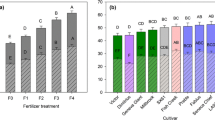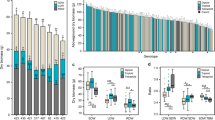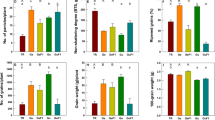Abstract
Key message
Novel interspecific hybrid progeny displayed hybrid vigor for some key biomass traits under well-watered and water-stressed conditions, but response was genotype-specific.
Abstract
Adaptation to stresses caused by climate change resulting from greenhouse gas emissions will become increasingly important for perennial crop breeding programs in the coming decades. Shrub willow (Salix spp.) is a strong candidate for short rotation coppice bioenergy production due to its high biomass production capacity, especially in temperate, northern latitudes. However, climate change is expected to increase temperature and the unpredictability of growing-season precipitation in these regions. Previous research has shown that interspecific breeding of shrub willow has resulted in hybrid vigor for biomass production. It is unclear how novel hybrids will perform in water limiting conditions. Using a biparental breeding scheme with common S. purpurea male or female parents, we tested parents and progeny for changes in growth and physiological traits under well-watered conditions and two levels of water stress. Water stress treatments caused reductions in above- and belowground biomass, leaf traits and stomatal conductance, mainly at the severe treatment level. At the genotypic level, hybrid progeny generally outperformed their parents for growth and biomass traits, demonstrating heterosis in these interspecific crosses. We found evidence that genotypes with the highest rates of biomass production are most severely impacted by water stress. Foliar SPAD measurements, a proxy for foliar N, were unaffected by water stress treatments. Biomass among genotypes in this controlled environment experiment was significantly correlated with field-grown plants, validating that these results can help to inform future breeding efforts targeting improved crop performance in drier growing environments.








Similar content being viewed by others
References
Blum A (2011) Drought resistance and its improvement. In: Plant breeding for water-limited environments. Springer New York, New York, pp 53–152
Bonosi L, Ghelardini L, Weih M (2010) Growth responses of 15 Salix genotypes to temporary water stress are different from the responses to permanent water shortage. Trees 24:843–854
Bonosi L, Ghelardini L, Weih M (2013) Towards making willows potential bio-resources in the South: Northern Salix hybrids can cope with warm and dry climate when irrigated. Biomass Bioenerg 51:136–144
Brereton NJB, Pitre FE, Shield I, Hanley SJ, Ray MJ, Murphy RJ, Karp A (2014) Insights into nitrogen allocation and recycling from nitrogen elemental analysis and 15N isotope labelling in 14 genotypes of willow. Tree Physiol 34:1252–1262
Fabio ES, Smart LB (2018) Differential growth response to fertilization of ten elite shrub willow (Salix spp.) bioenergy cultivars. Trees DOI. https://doi.org/10.1007/s00468-018-1695-y
Fabio ES, Kemanian AR, Montes F, Miller RO, Smart LB (2017a) A mixed model approach for evaluating yield improvements in interspecific hybrids of shrub willow, a dedicated bioenergy crop. Ind Crops Prod 96:57–70
Fabio ES, Volk TA, Miller RO, Serapiglia MJ, Gauch HG, Van Rees KCJ, Hangs RD, Amichev BY, Kuzovkina YA, Labrecque M, Johnson GA, Ewy RG, Kling GJ, Smart LB (2017b) Genotype × environment interaction analysis of North American shrub willow yield trials confirms superior performance of triploid hybrids. GCB Bioenergy 9:445–459
Farquhar GD, Buckley TN, Miller JM (2002) Optimal stomatal control in relation to leaf area and nitrogen content. Silva Fenn 36:625–637
Hayhoe K, Wake C, Anderson B, Liang X-Z, Maurer E, Zhu J, Bradbury J, DeGaetano A, Stoner AM, Wuebbles D (2008) Regional climate change projections for the Northeast USA. Mitig Adapt Strat Gl 13:425–436
Horton R, Yohe G, Easterling W, Kates R, Ruth M, Sussman E, Whelchel A, Wolfe D, Lipschultz F (2014) Chp. 16: Northeast. In: Melillo JM, Richmond TC, Yohe GW (eds) Climate Change Impacts in the United States. The Third National Climate Assessment. U.S. Government Printing Office, Washington, DC, pp 371–395
Karp A, Hanley SJ, Trybush SO, Macalpine W, Pei M, Shield I (2011) Genetic improvement of willow for bioenergy and biofuels. J Integr Plant Biol 53:151–165
Kuzovkina YA, Quigley MF (2005) Willows beyond wetlands: Uses of Salix L. species for environmental projects. Water Air Soil Pollut 162:183–204
Kuzovkina YA, Weih M, Romero MA, Charles J, Hust S, McIvor I, Karp A, Trybush S, Labrecque M, Teodorescu TI, Singh NB, Smart LB, Volk TA (2008) Salix: Botany and global horticulture. In: Janick J (ed) Horticultural reviews. Wiley, Hoboken, pp 447–489
Medrano H, Escalona JM, Bota J, GulÍAs J, Flexas J (2002) Regulation of photosynthesis of C3 plants in response to progressive drought: COND as a reference parameter. Ann Bot 89:895–905
Meredith MP, Stehman SV (1991) Repeated measures experiments in forestry: focus on analysis of response curves. Can J For Res 21:957–965
Quinn LD, Straker KC, Guo J, Kim S, Thapa S, Kling G, Lee DK, Voigt TB (2015) Stress-tolerant feedstocks for sustainable bioenergy production on marginal land. Bioenerg Res 8:1081–1100
Reynolds WD, Topp GC (2008) Soil water desorption and imbibition: tension and pressure techniques. Soil sampling and methods of analysis, 2nd edn. CRC Press, Boca Raton, pp 1025–1033
Rönnberg-Wästljung AC, Glynn C, Weih M (2005) QTL analyses of drought tolerance and growth for a Salix dasyclados × Salix viminalis hybrid in contrasting water regimes. Theor Appl Genet 110:537–549
Serapiglia MJ, Gouker FE, Smart LB (2014) Early selection of novel triploid hybrids of shrub willow with improved biomass yield relative to diploids. BMC Plant Biol 14:74
Smart LB, Cameron KD (2012) Shrub willow. In: Kole C, Joshi CP, Shonnard DR (eds) Handbook of bioenergy crop plants. Taylor and Francis Group, Boca Raton, pp 687–708
Stanton BJ, Serapiglia MJ, Smart LB (2014) The domestication and conservation of Populus and Salix genetic resources. In: Poplars and willows: trees for society and the environment. CAB International, Wallingford, pp 124–199
Stoof CR, Richards BK, Woodbury PB, Fabio ES, Brumbach AR, Cherney J, Das S, Geohring L, Hansen J, Hornesky J, Mayton H, Mason C, Ruestow G, Smart LB, Volk TA, Steenhuis TS (2015) Untapped potential: Opportunities and challenges for sustainable bioenergy production from marginal lands in the Northeast USA. Bioenerg Res 8:482–501
Street NR, Skogström O, Sjödin A, Tucker J, Rodríguez-Acosta M, Nilsson P, Jansson S, Taylor G (2006) The genetics and genomics of the drought response in Populus. Plant J 48:321–341
Volk TA, Abrahamson LP, Cameron KD, Castellano P, Corbin T, Fabio E, Johnson G, Kuzovkina-Eischen Y, Labrecque M, Miller R, Sidders D, Smart LB, Staver K, Stanosz GR, Van Rees KCJ (2011) Yields of willow biomass crops across a range of sites in North America. Asp Appl Biol 112:67–74
Volk TA, Berguson B, Daly C, Halbleib M, Miller R, Rials T, Abrahamson L, Buchman D, Buford M, Cunningham M, Eisenbies M, Fabio ES, Hallen K, Heavey J, Johnson G, Kuzovkina Y, Liu B, McMahon B, Rousseau R, Shi S, Shuren R, Smart LB, Stanosz G, Stanton B, Stokes B, Wright J (2018) Poplar and shrub willow energy crops in the United States: Field trial results from the multiyear regional feedstock partnership and yield potential maps based on the PRISM-ELM model. GCB Bioenergy. https://doi.org/10.1111/gcbb.12498
Weih M (2001) Evidence for increased sensitivity to nutrient and water stress in a fast-growing hybrid willow compared with a natural willow clone. Tree Physiol 21:1141–1148
Weih M (2009) Genetic and environmental variation in spring and autumn phenology of biomass willows (Salix spp.): effects on shoot growth and nitrogen economy. Tree Physiol 29:1479–1490
Weih M, Bonosi L (2009) Assessment of genotype ranking in long-term biomass production of Salix based on juvenile plant traits: Breeding implications. Bioenerg Res 2:29–36
Weih M, Nordh NE (2005) Determinants of biomass production in hybrid willows and prediction of field performance from pot studies. Tree Physiol 25:1197–1206
Weih M, Ronnberg-Wastljung AC (2007) Shoot biomass growth is related to the vertical leaf nitrogen gradient in Salix canopies. Tree Physiol 27:1551–1559
Weih M, Bonosi L, Ghelardini L, Ronnberg-Wastljung AC (2011) Optimizing nitrogen economy under drought: increased leaf nitrogen is an acclimation to water stress in willow (Salix spp.). Ann Bot 108:1347–1353
Wikberg J, Ögren E (2004) Interrelationships between water use and growth traits in biomass-producing willows. Trees 18:70–76
Wolfe DW, Degaetano AT, Peck GM et al (2018) Unique challenges and opportunities for northeastern US crop production in a changing climate. Clim Change 146:231–245
Zhivotovsky OP, Kuzovkina YA (2010) Response of two Salix L. species to water deficit. J Environ Hortic 28:63–68
Acknowledgements
We are grateful to Anna Agloro, Lauren Carlson, Dawn Fishback and Rebecca Wilk for their assistance with data collection and sample processing. Funding for this project was provided by the Agriculture and Food Research Initiative (AFRI) Competitive Grant No. 2012-68005-19703 from the US Department of Agriculture (USDA) National Institute of Food and Agriculture (NIFA) for the NEWBio Consortium and by USDA NIFA grant No. 2015-67009-23957. Anna Agloro and Carlie Leary were participants in the Cornell AgriTech Summer Research Scholars Program, which was partially supported by AFRI Grant #2016-67032-25009 from the USDA NIFA while this experiment was conducted.
Author information
Authors and Affiliations
Corresponding author
Ethics declarations
Conflict of interest
Lawrence Smart holds patents on the two commercial cultivars described in this paper, which are licensed for commercial sale.
Additional information
Communicated by Major.
Publisher’s Note
Springer Nature remains neutral with regard to jurisdictional claims in published maps and institutional affiliations.
Electronic supplementary material
Below is the link to the electronic supplementary material.
Rights and permissions
About this article
Cite this article
Fabio, E.S., Leary, C.J. & Smart, L.B. Tolerance of novel inter-specific shrub willow hybrids to water stress. Trees 33, 1015–1026 (2019). https://doi.org/10.1007/s00468-019-01835-4
Received:
Accepted:
Published:
Issue Date:
DOI: https://doi.org/10.1007/s00468-019-01835-4




